INN Index 2019
The 2019 INN Index report chronicles the state of nonprofit news, finding that public support is growing as more individuals donate.
The INN Index 2019 is based on 2018 data from nearly 60% of the INN membership across the United States. If you have questions about INN Index, please email news@inn.org.
DOWNLOAD THE REPORT
Below is the executive summary of the report. If you wish to read the executive summary as a PDF, download it here.
The previous year’s INN Index 2018 is available here.
Foreword
If you only remember three things from this report, here they are:
- Nonprofit newsrooms have been launching at a pace of more than one a month in the U.S. for almost 12 years.
- The people they serve support them in a major way. Individuals and families now donate nearly 40% of all the revenue going to news nonprofits. For the first time in studies of the field, foundation funding of nonprofit newsrooms fell below 50% in 2018.
- Nonprofits preserve expertise, depth and the watchdog role of journalism. Four out of five news nonprofits provide investigative or explanatory reporting.
More than statistics, these INN Index findings are signposts.
They point to communities rebuilding and reinventing the journalism they need. They point to growing awareness of nonprofit news and to thousands of people willing to act on that awareness and pay for quality journalism out of their own pockets. They point to new ways of providing news sources that people can trust.
In a harsh environment where cuts and consolidation gut the reporting power of commercial newsrooms, where a free press and the public’s right to know are under attack by powerful governments, these findings point to the need for a new kind of news. In this report, you can see it being created.
How we, the people, support a free press in our democracy is one of the great challenges of our time.
The newsrooms that INN is privileged to support, newsrooms that shared information so generously to create this INN Index, embrace that challenge. They will face many more as they fight to make sure Americans have independent, credible news for all time. But these newsrooms are gaining. With your support, they are forging a new kind of news: independent, inclusive, nonprofit, nonpartisan.

Sue Cross
INN Executive Director & CEO
About the Survey
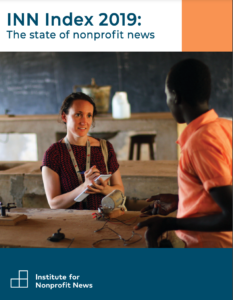
The survey of 108 INN members was conducted online in March-April 2019. The responses reflect performance during the fiscal year ending in 2018.
With a response rate of 56%, the survey sample is representative of all INN members other than public broadcasters, and the results give a comprehensive picture of the state of nonprofit news outlets. The data do not scientifically represent all U.S. nonprofit news outlets, since not all belong to INN. This report excluded data from public broadcasters as they do not generally break out news revenue and expenses in a comparable way.
INN Index launched in 2018. Specific year-over-year comparisons should be interpreted cautiously; this report draws directional trends across the overall data.
Executive Summary
Nonprofit news is rapidly expanding and gaining public support as individuals donate more to news sites
Financial support for public service journalism is shifting substantially, from foundations to individual supporters of nonprofit newsrooms. Donations from individuals and families provided nearly 40% of the funding that independent news nonprofits reported in 2018. That is nearing the levels of support these newsrooms receive from foundation grants.
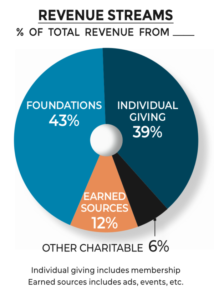
And for the first time in years of studies of the nonprofit news field, nonprofit newsrooms reported less than half of their revenue — 43% on average — came from foundations. By comparison, the Pew Research Center found that in 2011, foundations contributed nearly two-thirds of revenue while donors accounted for about a fourth across the nonprofit news field.
The new data comes from the INN Index, a periodic survey of North American nonprofit news organizations that are members of the Institute for Nonprofit News. INN is a network of 501(c)3 nonprofits that focus on independent, nonpartisan journalism with a commitment to editorial independence and transparency.
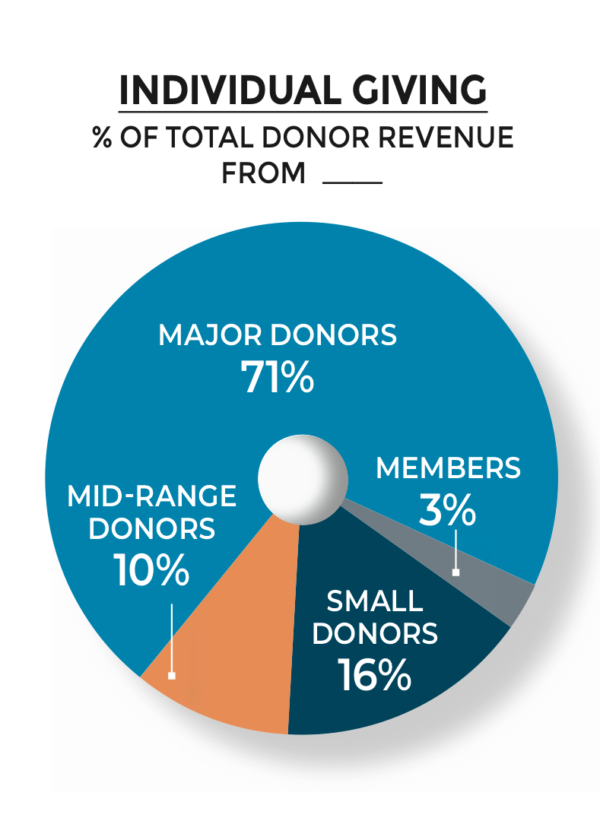
The INN Index study was conducted in spring 2019 and is based on 2018 financial and operational data from 108 participating newsrooms.
The study also underscores the tremendous growth of the nonprofit news field since it took off about a decade ago. Nearly three-quarters of INN’s more than 230 members have launched since 2008, an average of more than one new startup per month for almost 12 years.
By the end of 2018, INN members had a total estimated staff of nearly 3,000, including about 2,000 journalists, and generated annual revenue of roughly $450 million.
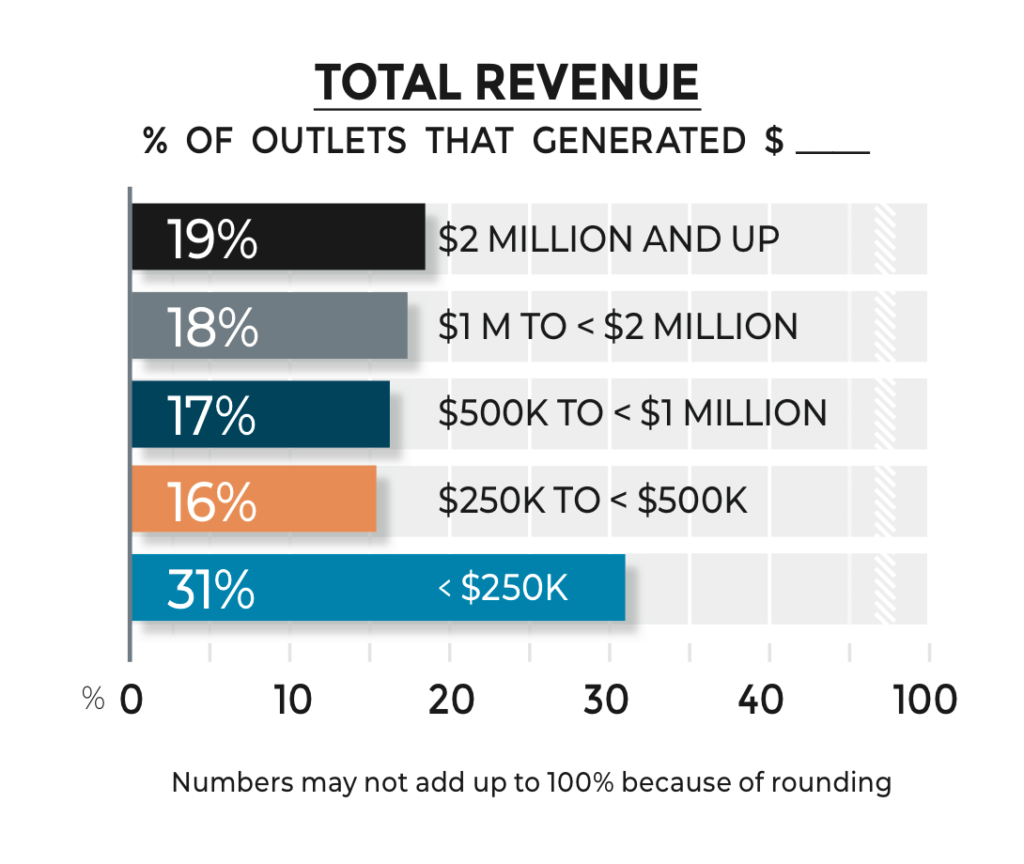
Several currents have combined to create broader opportunities for news philanthropy. Heightened public awareness of the spread of disinformation and deep declines in the news industry, plus political attacks on the press, have by many accounts increased public understanding of the crisis in journalism.
At the same time, nonprofit news publishers stepped up efforts to engage with their communities and readers. Publishers also were able to tap significant training, tools and other capacity-building resources provided by foundations and other support programs to help them raise their fundraising expertise.
News nonprofits are starting to mature into different segments with varying business models and support profiles, so revenue trends vary considerably between local, state, national and global organizations, and between general and topic-focused publications.
But overall, the increase in individual-giving donor revenue was driven by donors of $5,000 or more, who accounted for more than two-thirds of all donor revenue.
Reader revenue plays a much smaller but still substantial role, providing almost one-tenth of revenue. Small donations accounted for most of this, with a sliver from membership. Nearly a third of the news organizations reported having a membership program in 2018 but most of these programs are very young — less than 3 years old — and may not have realized their full revenue potential. Sixteen percent said they planned to launch membership programs.
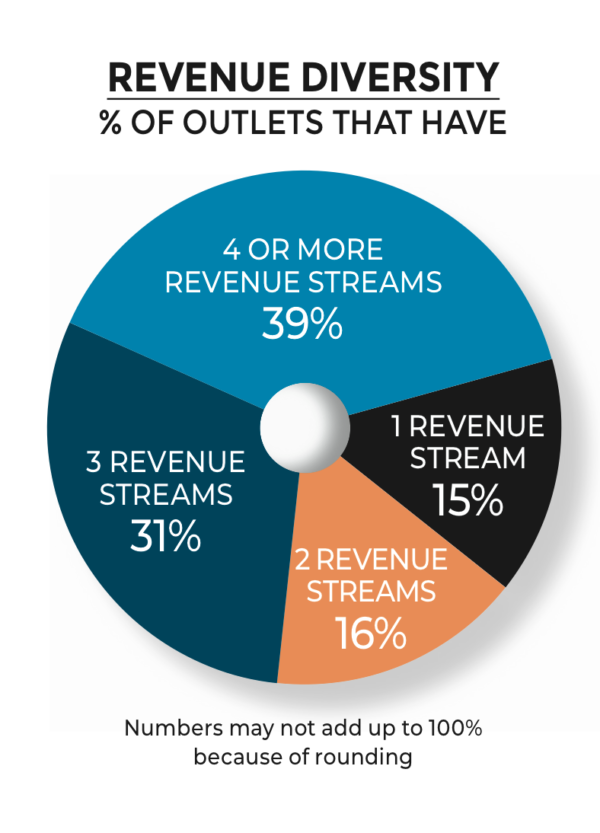
Earned revenue sources play a small role in the entire revenue mix. But some organizations have built large shares of their total revenue from one or more earned sources — such as advertising, sponsorships or events — that are proving effective for their model or market. Earned revenue accounted for 12% of total revenue. The largest sources were advertising, sponsorships, events and subscriptions, with none topping 3%.
On the whole, the data points to nonprofits achieving financial stability. More than half of the organizations generated $500,000 or more in total revenue in 2018 and more than a third generated $1 million or more. Their position has improved significantly since 2015, when fewer than a third of INN members took in $500,000 or more.
More than two-thirds now report having three or more revenue streams, another indicator of financial stability.
Yet there still is considerable room for growth in individual news philanthropy. The 39% of revenue coming to news nonprofits from individual donors compares with 70% of charitable revenue for all types of nonprofits, according to GivingUSA.
Nonprofits are filling gaps in the journalism ecosystem
Investigative, watchdog and deep explanatory journalism are the focus and mission of most nonprofit news organizations. Four in five provide investigative or explanatory reporting and three in five concentrate on in-depth coverage of a single topic or a number of related topics.
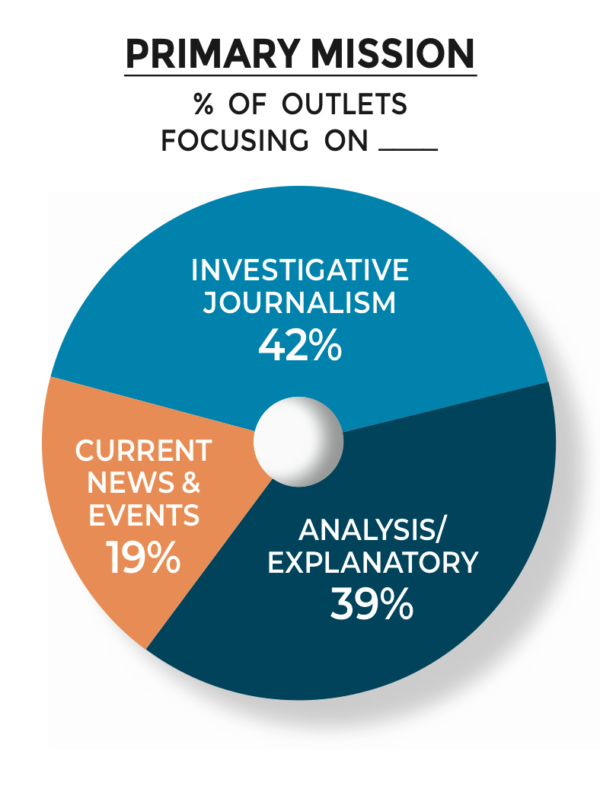
Local nonprofits are more likely to cover general news in their community. Even with local newsrooms counted, more than three-fourths of the nonprofits have at least one investigative reporter. The nonprofits also fight government secrecy and advance public access to information in significant ways beyond story reporting. The 108 publications surveyed filed 31,011 public records requests in 2018 and more than 40% of the newsrooms made at least one database available for public use.
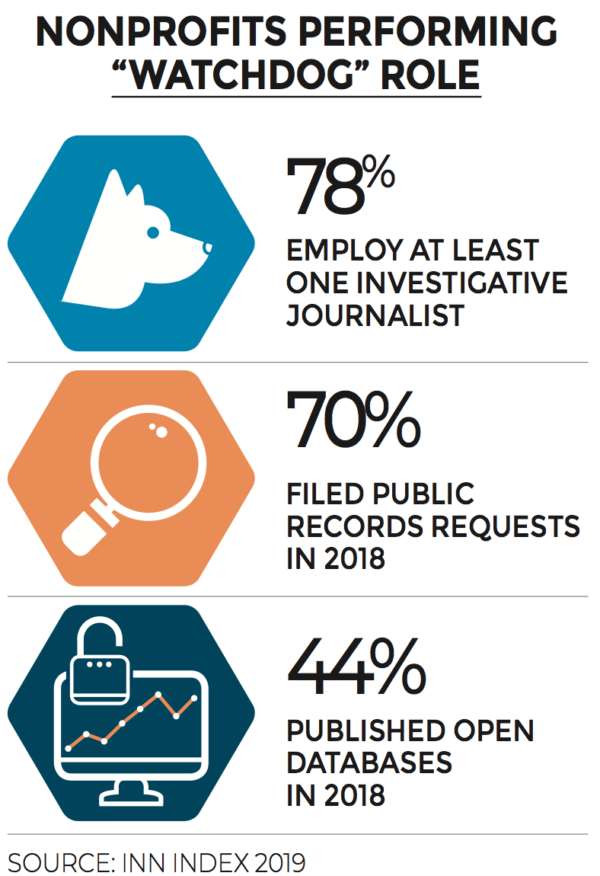
Their reporters tend to focus on complex topics in the realm of public affairs. Government and politics, environment, education and social justice are among the most common. The sector is expanding into topical or beat coverage and state and local community coverage to fill gaps left by commercial media.
Distinct geographic models are emerging
The distinctions between a local community news site and a national news program lead to differences in journalistic practices, revenue models and reach.
About half of the news nonprofits are national or global and they capture more than three-quarters of the revenue across the field. (We include in this group about a dozen multistate regional publications, which as a group have models akin to national publications.)
The national/global news outlets tend to be investigative powerhouses, often homing in on a single topic. Fully nine in 10 describe themselves as either investigative or explanatory. More than a third specialize in a single subject.
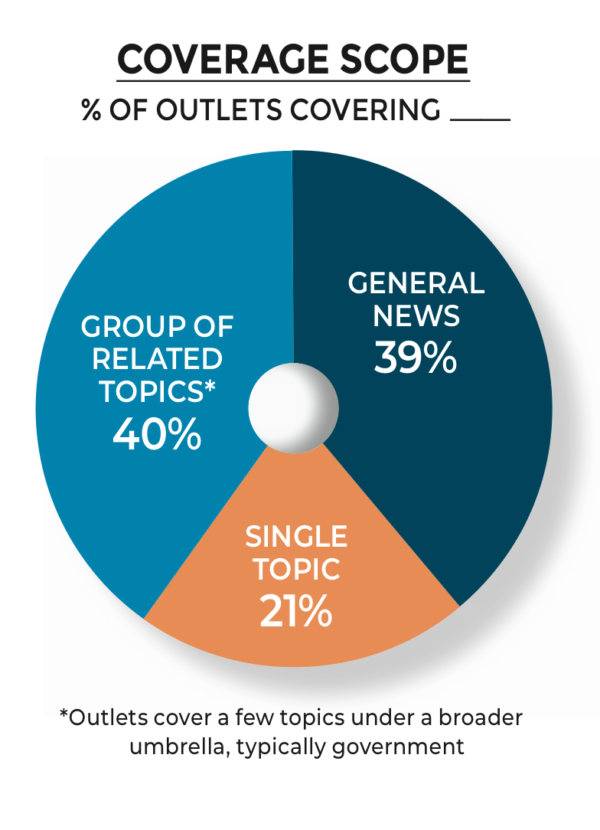
State-focused outlets account for a quarter of the news nonprofits. Many seek to fill a gap in public affairs coverage either with statehouse or statewide policy news. Most cover a variety of subjects or a set of interrelated topics.
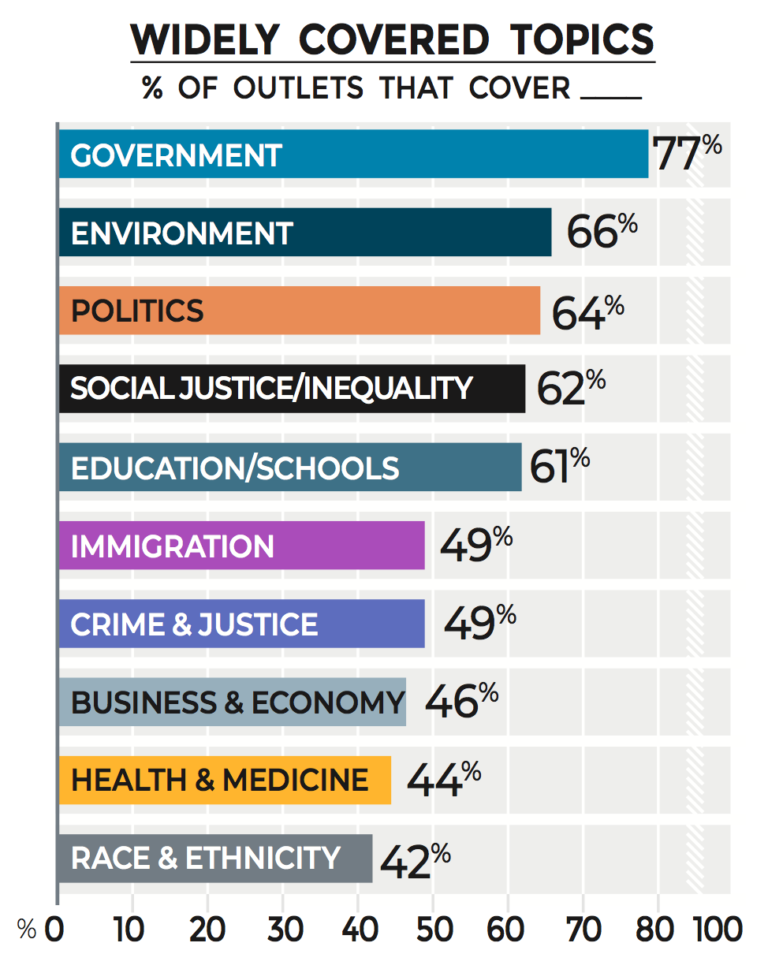
State outlets on the whole have a healthy mix of revenue streams, with individual giving (especially from major donors) outpacing foundation grants, and earned revenue — such as advertising and events — accounting for one-fourth of their total revenue. State outlets’ web audiences tend to be larger than those of national/global and local outlets on average, while national/global outlets lead when it comes to the average number of newsletter subscriptions.
Local newsrooms account for about one in four news nonprofits. These outlets are more likely to fill the gaps in general news coverage, often covering a range of subjects.
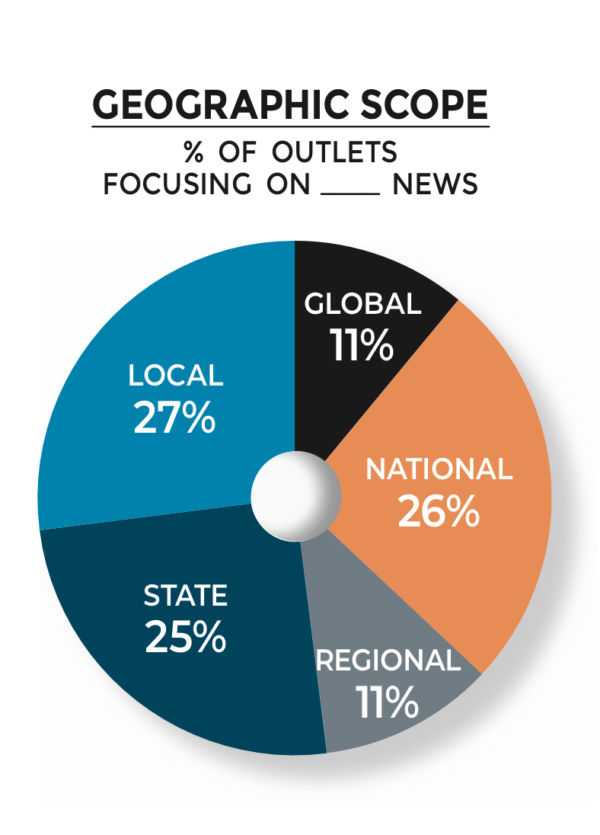
Local outlets may serve smaller communities, which presents challenges of scale because they have smaller markets from which to build revenue. Their revenue and direct audience reach are usually modest. As a group, these outlets are investing more of their operating budget into revenue generation, one sign of commitment to growing organizational capacity.
Efforts are increasing to reach audiences directly
Elevating their brands and increasing direct connections to audience continue to pose challenges for nonprofit news organizations. Three-quarters of them publish through third parties. Many organizations (and often their funders) view news-sharing and collaboration as part of their mission. It also makes sense for startups seeking visibility.
However, nonprofit newsrooms increasingly are taking a two-track approach to distribution and building an audience. They continue to build reach on traditional media and digital platforms. At the same time, many are working to develop their own loyal audiences on the web and through newsletters. This direct engagement enables them to better establish their brand and build an individual donor base.
Nearly half say their website of mobile platforms are their primary method of distribution and nearly one-fourth mix direct and third-party publication methods. The remaining outlets distribute their work primarily through other news outlets.
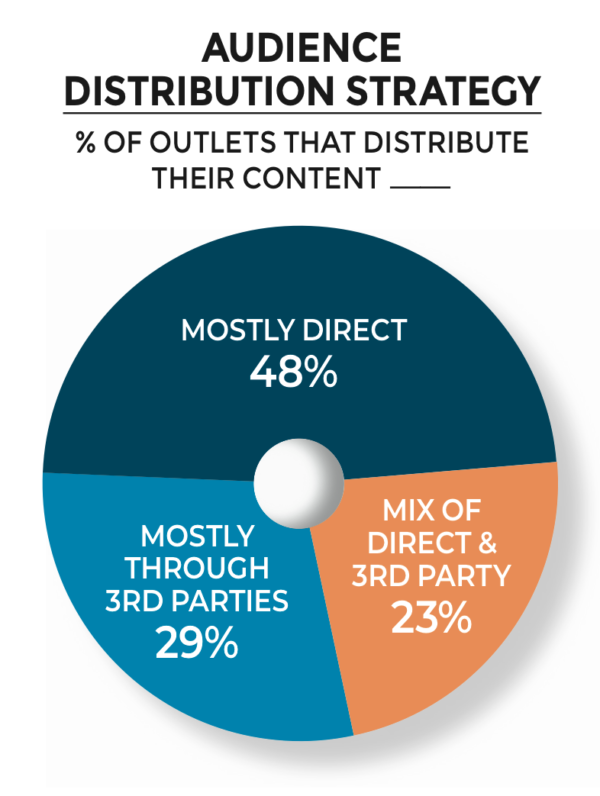
Investment in revenue development remains low for an emerging field
Nonprofit news publishers know they need to build capacity. However, they invest minimally in revenue development at a time when the disruption of economic models in journalism requires innovation and warrants more such investment. Some report pressure from funders to keep revenue generation costs low. In 2018, spending on revenue generation accounted for only 15% of total operating expenses across all the outlets surveyed, about one-fourth the share devoted to editorial.
There are signs this may be changing.
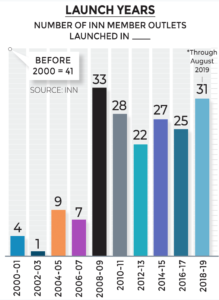
A comparison of data for 47 outlets that provided expense information for 2017 and 2018 showed a shift in resource allocation away from editorial toward business functions.
Training in fundraising and capacity building are routine and more widely available than before. Many INN members have now hired development directors and about half have a full-time person devoted to fundraising. And the old caricature of the nonprofit newsroom CEO who only knows how to edit copy is obsolete: A third of all CEO time is spent on fundraising.
Conclusion
Nonprofit news organizations will increasingly be clustered into distinct models shaped by factors such as the geographic region they serve, how often they publish and the range of topics covered. Indeed, the smart publishers will be those who identify what works well for those sharing common characteristics.
Data on nonprofit news revenue shows growing numbers of people are willing to financially support a free press on an ongoing basis. Efforts to diversify revenue and lessen reliance on foundation grants are beginning to pay off in the form of individual donations, especially major gifts. This growth has come during a strong economy and some worry that giving could slow in a recession. But the last recession saw a boom in nonprofit news, and a recession’s impact on commercial media could also accelerate the move to alternatives.
News sites must keep innovating on ways to help people find them. Most news nonprofits are young. They are still establishing their brands. Getting discovered will remain a complex challenge for all types of emerging news outlets.
Many nonprofit news organizations reach people by sharing or syndicating their news through large, legacy media outlets. That third-party distribution can provide startups with an instant reader base but obscure their brands, blocking or delaying their abilities to build a loyal following and direct revenue.
Expect to see nonprofit newsrooms keep searching and experimenting to find the right balance between building their own grassroots connections with consumers and leveraging other media for distribution. The two-track strategy of doing both is likely to continue for specialized and high-investment reporting such as investigative work.
The nonprofit news field needs better measurement of third-party distribution and reader engagement to understand these trends, and how consumers find, recognize and choose to trust news sources.
Earned revenue shows potential for greater growth, particularly in sponsorship and underwriting. The revenue realized by a few leaders in this area shows it has potential for others.
Overall, news leaders and their funders would be wise to concentrate greater resources on long-term revenue development for news. That kind of added effort is supporting rapid growth in nonprofit journalism, and there is momentum to build on through the next few years and beyond.
The ongoing disruption and reinvention of the news industry means that needs are growing for newsrooms producing the kind of trusted public service journalism that we now see communities are willing to step up and support.

INN Index Participants (Thank you!)
Adirondack Explorer
Alabama Initiative for Independent Journalism
Alicia Patterson Foundation
Anthropocene Magazine
Arkansas Nonprofit News Network
Aspen Journalism
Baltimore Brew
Bay Journal
Bay Nature Institute
Belt Magazine
BenitoLink
Borderzine
Boyle Heights Beat
Bridge Magazine
Brown Impact Media Group/Flint Beat
CalMatters
Chalkbeat
Charlottesville Tomorrow
City Bureau
City Limits
CivicStory
Connecticut Health I-Team
Connecticut Mirror
Current
Daily Yonder
Delaware Currents
East Lansing Info (ELi)
Economic Hardship Reporting Project
ecoRI News
EdSource
Energy News Network
Ensia
FairWarning
Food and Environment Reporting Network
Fostering Media Connections
Futuro Media
Georgia News Lab
Hidden City Philadelphia
High Country News
Highlands Current
In These Times
inewsource
Injustice Watch
International Consortium of Investigative Journalists
InvestigateWest
Investigative Reporting Workshop
Iowa Center for Public Affairs Journalism
KCUR
Kentucky Center for Investigative Reporting
LkldNow
Lower Cape TV
Madison365
Maryland Matters
Midwest Center for Investigative Reporting
Migratory Notes
MinnPost
Mississippi Today
Mother Jones
Mountain Independent
MuckRock
National Institute on Money in Politics
New England Center for Investigative Reporting
New Hampshire Center for Public Interest Journalism
New Haven Independent
New Mexico In Depth
Next City
NJ Spotlight
Nonprofit Quarterly
North Carolina Health News
Northern Kentucky Tribune
Ohio Center for Investigative Journalism
Oklahoma Watch
OrbMedia
PassBlue
Patagonia Regional Times
Philadelphia Public School Notebook
PRI
ProPublica
PublicSource
Pulitzer Center on Crisis Reporting
Retro Report
Searchlight New Mexico
Shelterforce
Solitary Watch
Texas Observer
The Austin Bulldog
The Center for Investigative Reporting
The Chicago Reporter
The Colorado Independent
The Conversation US
The Forward
The Frontier
The GroundTruth Project
The Hartford Guardian
The Hechinger Report
The Lens
The Marshall Project
The Narwhal
The Nevada Independent
The New Food Economy
The Seattle Globalist
The Texas Tribune
The Trace
The War Horse
Threshold
Type Investigations
Voice of San Diego
Voices of Monterey Bay
VTDigger
Wausau Pilot and Review
Wisconsin Center for Investigative Journalism
Workday Minnesota
WITF/PA Post
WyoFile
Yale Environment 360
Report Credits
Authors: Michele McLellan, Jesse Holcomb
Editor: Howard Goldberg
Graphic designer: Michelle D. Wise
Cover photo courtesy of the The Hechinger Report
